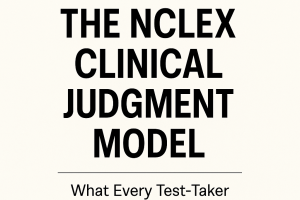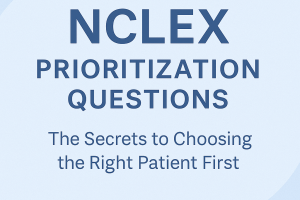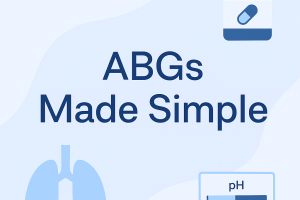Understanding Anxiety Disorders: A Guide for the NCLEX Exam

Anxiety disorders are among the most common mental health conditions that nurses encounter. For the NCLEX exam, understanding the different types of anxiety disorders, their symptoms, and appropriate nursing interventions is crucial. This blog post provides a comprehensive overview of anxiety disorders and includes practice questions to help you prepare for the NCLEX exam.
What Are Anxiety Disorders?
Anxiety disorders are a group of mental health conditions characterized by excessive fear, worry, and related behavioral disturbances. These disorders can significantly impair daily functioning and quality of life. The main types of anxiety disorders include:
- Generalized Anxiety Disorder (GAD)
- Panic Disorder
- Social Anxiety Disorder (Social Phobia)
- Specific Phobias
- Obsessive-Compulsive Disorder (OCD)
- Post-Traumatic Stress Disorder (PTSD)
- Separation Anxiety Disorder
Generalized Anxiety Disorder (GAD)
Pathophysiology:
GAD is characterized by persistent, excessive worry about various aspects of life, such as health, work, or relationships. The anxiety is often disproportionate to the actual situation.
Symptoms:
- Excessive worry or fear
- Restlessness
- Fatigue
- Difficulty concentrating
- Irritability
- Muscle tension
- Sleep disturbances
Nursing Interventions:
- Encourage the use of relaxation techniques (e.g., deep breathing, progressive muscle relaxation).
- Educate the patient about the importance of regular physical activity.
- Provide support and reassurance to help reduce anxiety.
- Encourage the use of cognitive-behavioral therapy (CBT) techniques.
Panic Disorder
Pathophysiology:
Panic disorder involves recurrent, unexpected panic attacks—sudden periods of intense fear or discomfort that peak within minutes.
Symptoms:
- Palpitations or rapid heart rate
- Sweating
- Trembling or shaking
- Shortness of breath
- Chest pain or discomfort
- Nausea
- Dizziness or lightheadedness
- Fear of losing control or dying
Nursing Interventions:
- Stay with the patient during a panic attack to provide reassurance.
- Encourage slow, deep breathing to help manage symptoms.
- Educate the patient on the use of anti-anxiety medications, if prescribed.
- Discuss the benefits of psychotherapy, particularly CBT.
Social Anxiety Disorder (Social Phobia)
Pathophysiology:
Social anxiety disorder involves an intense fear of social situations where the individual may be exposed to scrutiny or judgment by others.
Symptoms:
- Fear of being embarrassed or humiliated in social situations
- Avoidance of social interactions
- Physical symptoms such as blushing, sweating, or trembling in social situations
Nursing Interventions:
- Encourage gradual exposure to feared social situations in a controlled manner.
- Provide positive reinforcement for social interactions.
- Teach relaxation techniques to manage anxiety in social settings.
- Educate the patient about the use of selective serotonin reuptake inhibitors (SSRIs) if prescribed.
Specific Phobias
Pathophysiology:
Specific phobias involve an intense, irrational fear of specific objects or situations (e.g., heights, spiders, flying).
Symptoms:
- Immediate anxiety response upon exposure to the phobic stimulus
- Avoidance of the phobic object or situation
- Physical symptoms such as sweating, trembling, or rapid heartbeat
Nursing Interventions:
- Use exposure therapy to gradually desensitize the patient to the phobic stimulus.
- Educate the patient about the nature of phobias and treatment options.
- Encourage the use of relaxation techniques during exposure to the phobic stimulus.
Obsessive-Compulsive Disorder (OCD)
Pathophysiology:
OCD is characterized by recurrent, unwanted thoughts (obsessions) and repetitive behaviors (compulsions) performed to reduce anxiety.
Symptoms:
- Obsessions: Intrusive thoughts, images, or urges (e.g., fear of contamination)
- Compulsions: Repetitive behaviors or mental acts (e.g., handwashing, checking)
Nursing Interventions:
- Encourage the patient to gradually reduce compulsive behaviors.
- Teach the use of thought-stopping techniques to manage obsessions.
- Discuss the benefits of CBT and SSRIs in managing OCD symptoms.
- Provide a supportive environment to reduce stress and anxiety.
Post-Traumatic Stress Disorder (PTSD)
Pathophysiology:
PTSD develops after exposure to a traumatic event, such as combat, natural disasters, or personal assault.
Symptoms:
- Re-experiencing the traumatic event (e.g., flashbacks, nightmares)
- Avoidance of reminders of the trauma
- Negative changes in thoughts and mood
- Hyperarousal (e.g., irritability, difficulty sleeping, exaggerated startle response)
Nursing Interventions:
- Encourage the use of grounding techniques to manage flashbacks.
- Provide a safe and supportive environment for the patient.
- Educate the patient about the importance of therapy, including trauma-focused CBT and eye movement desensitization and reprocessing (EMDR).
- Discuss the use of medications, such as SSRIs and prazosin, for managing PTSD symptoms.
Separation Anxiety Disorder
Pathophysiology:
Separation anxiety disorder is characterized by excessive fear or anxiety about being separated from attachment figures.
Symptoms:
- Distress when anticipating or experiencing separation from home or loved ones
- Reluctance or refusal to go out due to fear of separation
- Physical symptoms (e.g., headaches, stomachaches) when separation is anticipated
Nursing Interventions:
- Encourage gradual exposure to separation to help reduce anxiety.
- Provide reassurance and support to both the patient and their caregivers.
- Teach relaxation techniques to manage anxiety.
- Educate the patient and family about the importance of therapy, including CBT.
Sample NCLEX Questions
Question 1
A patient with generalized anxiety disorder (GAD) is being discharged with a prescription for buspirone. Which statement by the patient indicates an understanding of the medication?
A. “I should take this medication only when I feel anxious.”
B. “It may take several weeks before I notice the full effects of the medication.”
C. “I can drink alcohol while taking this medication.”
D. “This medication will make me sleepy, so I should take it at bedtime.”
Answer: B. “It may take several weeks before I notice the full effects of the medication.”
Question 2
A nurse is caring for a patient with panic disorder who is experiencing a panic attack. Which of the following actions should the nurse take first?
A. Administer an as-needed dose of lorazepam.
B. Encourage the patient to take deep, slow breaths.
C. Leave the patient alone in a quiet room.
D. Ask the patient what triggered the panic attack.
Answer: B. Encourage the patient to take deep, slow breaths.
Question 3
A patient with obsessive-compulsive disorder (OCD) spends several hours each day washing their hands. Which nursing intervention is most appropriate?
A. Allow the patient to continue their handwashing ritual to reduce anxiety.
B. Encourage the patient to set a time limit for handwashing and gradually reduce the time.
C. Tell the patient to stop handwashing immediately as it is not necessary.
D. Distract the patient with other activities to prevent handwashing.
Answer: B. Encourage the patient to set a time limit for handwashing and gradually reduce the time.
Question 4
A nurse is caring for a veteran who has been diagnosed with post-traumatic stress disorder (PTSD). The patient reports difficulty sleeping due to nightmares. Which of the following medications should the nurse anticipate being prescribed?
A. Prazosin
B. Lorazepam
C. Fluoxetine
D. Buspirone
Answer: A. Prazosin
NCLEX Preparation Tips for Anxiety Disorders
- Understand the Different Types: Be familiar with the various anxiety disorders and their distinguishing features.
- Memorize Key Symptoms: Recognize the classic symptoms associated with each anxiety disorder.
- Diagnostic Criteria: Review the DSM-5 criteria for each anxiety disorder.
- Treatment Modalities: Understand the common treatments, including medications and therapy options.
- Practice Questions: Use NCLEX practice questions focused on anxiety disorders to reinforce your knowledge and improve your test-taking skills.
Conclusion
Anxiety disorders are a crucial part of the NCLEX exam, requiring a strong understanding of their pathophysiology, symptoms, and treatment options. By studying these disorders and practicing NCLEX-style questions, you’ll be well-prepared to handle related questions on the exam and provide compassionate care to patients experiencing anxiety disorders. Keep studying, practicing, and applying your knowledge to ensure you excel in your nursing career.






